The USS Arizona - A Symbol of Valor and Sacrifice -
By: Craig Ryan (NavalHistoria)

The USS Arizona - A Symbol of Valor and Sacrifice
The USS Arizona, one of the most recognizable names in American naval history, serves as an emblem of valor, sacrifice, and resilience.
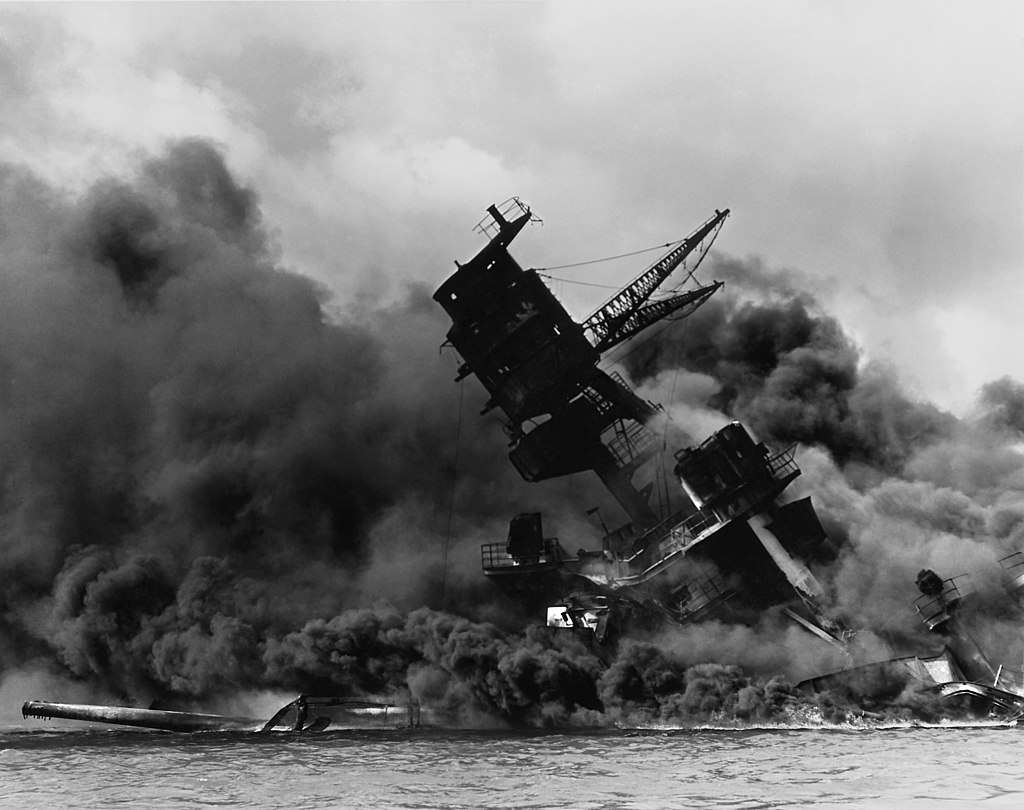
The USS Arizona, commissioned in 1916, was a super-dreadnought battleship that represented a pinnacle of American naval architecture during the early 20th century.
Its tragic sinking during the surprise Japanese attack on Pearl Harbor on December 7, 1941, resulted in the greatest loss of life on any U.S. warship in history and marked the United States' entry into World War II.
Today, the sunken remains of the USS Arizona and its memorial stand as poignant symbols of sacrifice and bravery, attracting over a million visitors annually.
The Birth Of The USS Arizona
As the 20th century unfolded, the global community was swept into an era of geopolitical tensions and rivalries. Amidst this, the United States of America recognized the need to fortify its defenses.
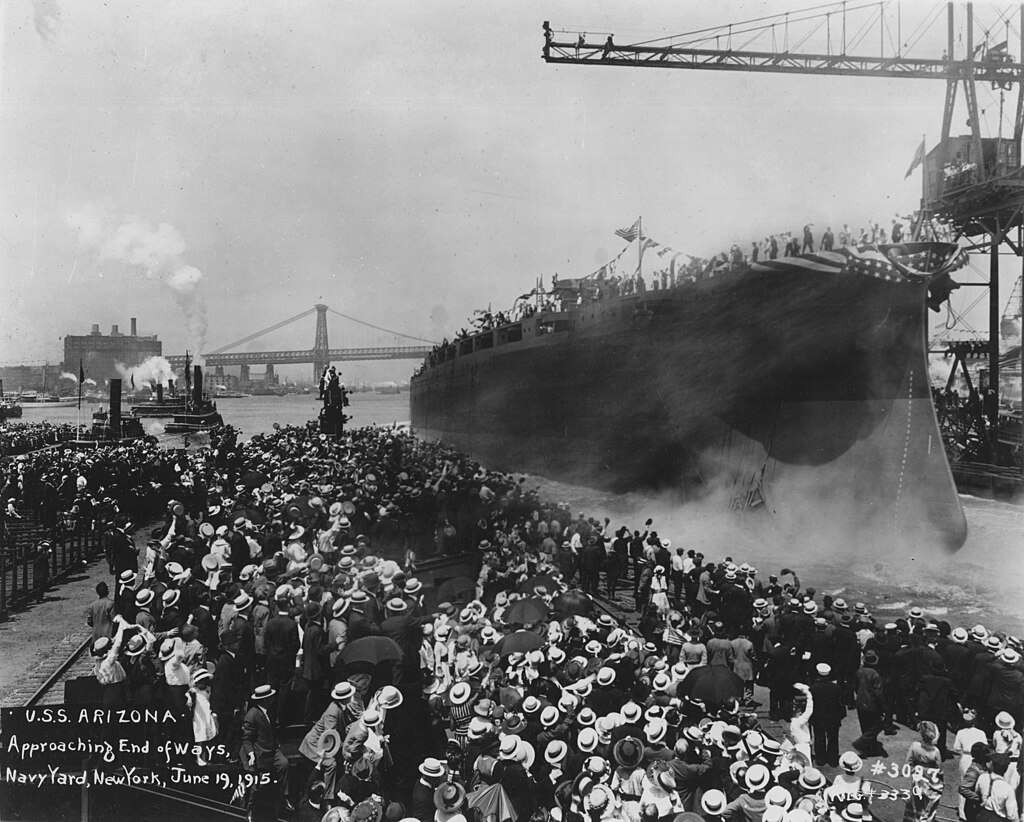
Launching the USS Arizona in 1915.
The USS Arizona was laid down on March 16, 1914, in the historic Brooklyn Navy Yard.
Named after the 48th state, the Arizona was part of the Pennsylvania class of 'super-dreadnought' battleships, a class that embodied the latest advancements in naval warfare technology and design.
The construction of the USS Arizona coincided with a period of rapid technological changes. It represented the United States' ambition to create a formidable naval fleet that could compete with the major maritime powers of that time.
The focus was on building heavily armed and armored battleships that could meet any naval challenge head-on. This philosophy was encapsulated in the design of the USS Arizona, which represented the pinnacle of American naval engineering when it was commissioned on October 17, 1916.
Architectural Marvel of Its Time
The USS Arizona's design and construction incorporated cutting-edge technology and a forward-thinking strategy, reflecting the evolving trends in naval warfare and positioning the United States as a major maritime power.
At an imposing length of 608 feet and a breadth of 97 feet, the Arizona was a behemoth, engineered to showcase the might of the American navy.
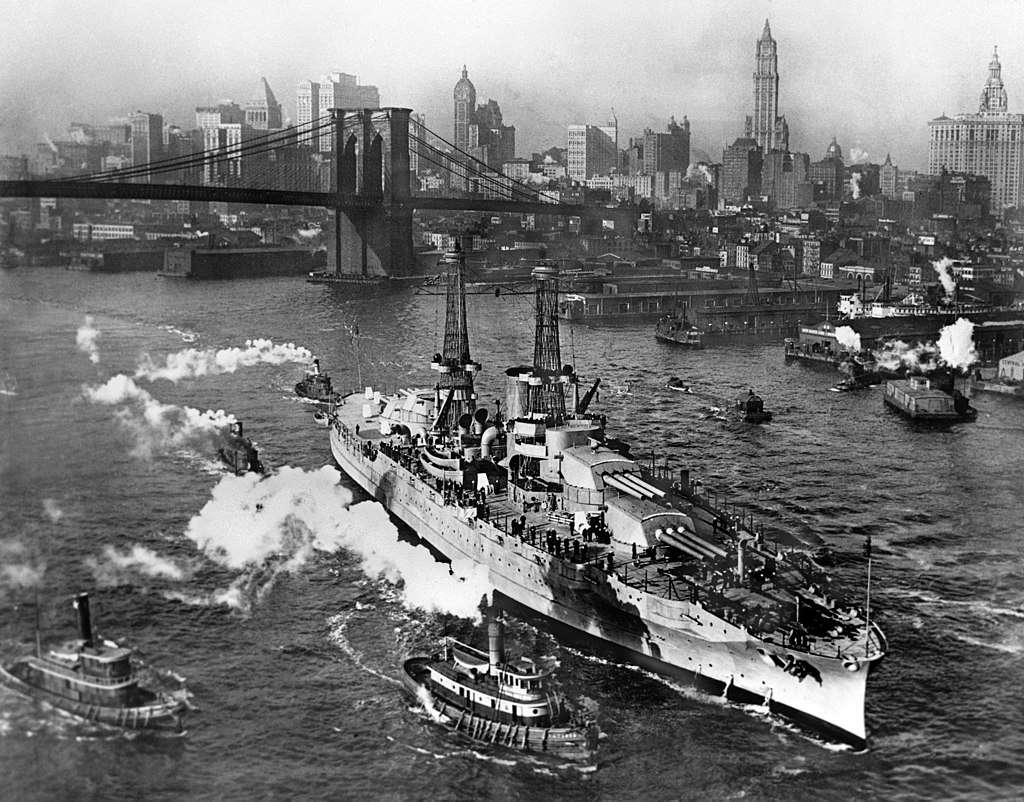
The USS Arizona in New York City, 1916.
It was armed with a formidable arsenal of twelve 14-inch guns in four triple turrets and twenty-two 5-inch guns. This massive firepower, combined with the ability to launch shells over 20,000 yards, rendered the Arizona a formidable force on the seas.
The battleship's armor, too, was noteworthy. With a belt armor reaching up to 13.5 inches thick and turret armor up to 18 inches, the Arizona was designed to withstand substantial enemy fire.
A particularly innovative feature of the USS Arizona was its inclusion of aircraft technology. At a time when the concept of the aircraft carrier was still in its infancy, the Arizona incorporated aircraft launching capabilities.
Equipped with three catapults for launching spotter planes, the Arizona could extend its sight far beyond the horizon, scouting for enemy ships and providing accurate target data for its guns.
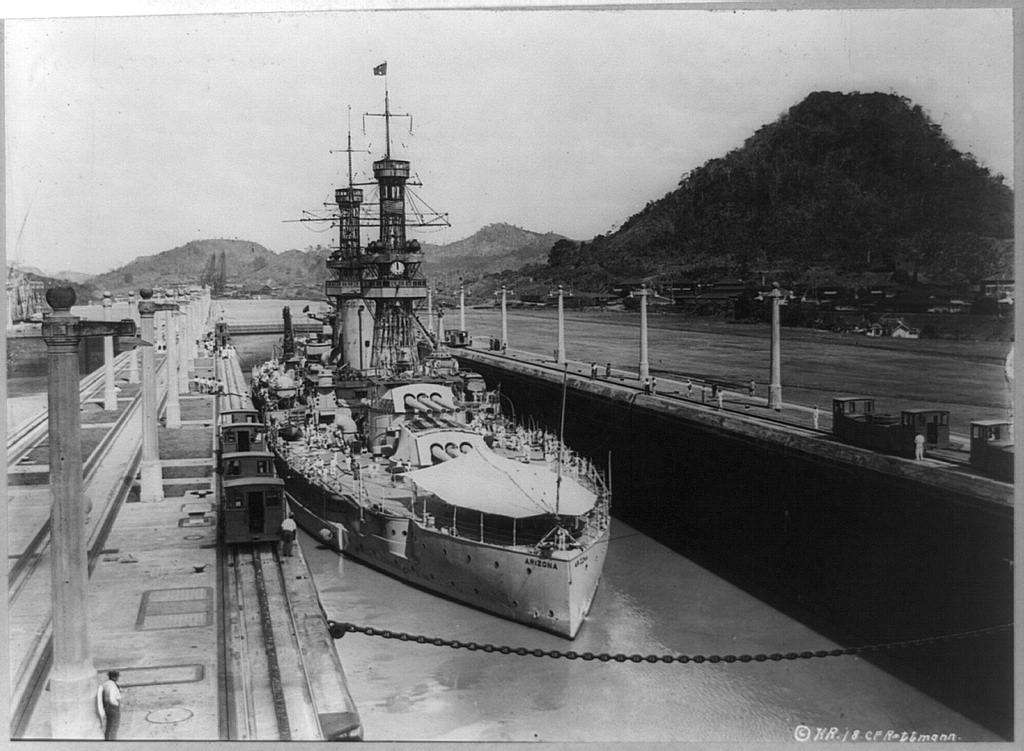
USS Arizona in one of the locks in the Panama Canal, 1921.
This forward-thinking approach allowed the USS Arizona to adapt to the evolving trends in naval warfare, shifting from pure surface engagements towards a new age where air power would become increasingly vital.
Moreover, the ship was also designed with crew comfort in mind. It boasted relatively spacious quarters, a medical dispensary, a cobbler shop, and even a tailor shop.
The Sinking of the USS Arizona
The sinking of the USS Arizona during the attack on Pearl Harbor stands as one of the most heart-wrenching moments of World War II.
In those frantic and terrifying moments, the battleship and much of her crew were lost, marking a devastating chapter in American naval history.
On the morning of December 7, 1941, Pearl Harbor was shrouded in the peaceful calm of a Sunday.
The serenity was violently shattered at 7:55 am when waves of Japanese aircraft, launched from six aircraft carriers stationed northwest of Hawaii, commenced an unprovoked and surprise assault on the harbor.
The attack targeted the Navy's aircraft carriers and fleet, with eight battleships, including the USS Arizona, stationed at Battleship Row.
In the onslaught that followed, the USS Arizona became a prime target for the Japanese bombers.
Approximately 15 minutes into the attack, a 1,760-pound armor-piercing bomb, dropped from a Japanese Nakajima B5N2 'Kate' torpedo bomber, found its mark on the Arizona.
The bomb struck the deck and penetrated into the forward magazine, where the ship's ammunition was stored.
The resulting explosion was cataclysmic.

The USS Arizona after the attack on Pearl Harbor.
It caused a massive fireball that was seen across the harbor, and the shockwave from the detonation lifted the 31,400-ton battleship out of the water.
Within mere seconds, the forward part of the ship was obliterated, a gaping hole marking where it once stood. The explosion tore the ship apart, igniting fires that would continue to burn for two days.
The USS Arizona sank in just nine minutes, its superstructure collapsing and its hull settling into the mud of the harbor.
Tragically, out of the ship's crew of approximately 1,512 men, 1,177 perished. Many of these men were trapped inside the sinking battleship, their escape routes cut off by flames, twisted metal, and rapidly rising water.
After The Attack
Following the devastating attack on Pearl Harbor and the sinking of the USS Arizona, the battleship lay at the bottom of the harbor as a grim reminder of the tragedy.
The sunken vessel, still visible above the waterline, was deemed irreparable and was never raised or refloated. It was subsequently decommissioned on December 29, 1941.
In the immediate aftermath of the attack, the salvage operations focused on recovering anything of value from the ship and making the harbor usable again.
Notably, the USS Arizona's superstructure, including the masts and the main battery turrets, were removed and repurposed. Two of the Arizona's three main battery gun turrets were reinstalled at the entrance of Pearl Harbor as part of Battery Pennsylvania, where they provided coastal defense during World War II.
Despite the salvage operations, the remains of over 900 sailors and marines are still entombed within the sunken battleship, their final resting place marked by the rusting hull of the USS Arizona.
Oil from the ship continues to leak into the harbor, referred to as the "tears of the Arizona" or "black tears," serving as a haunting reminder of the lives lost.
The USS Arizona Memorial
The USS Arizona Memorial is a monumental tribute to the courage and sacrifice of the men who served on the battleship during the attack on Pearl Harbor.
The memorial is not just a structure, but a sacred site, a testament to the resilience of the human spirit, and a poignant reminder of one of the most tragic events in American military history.
The journey towards establishing a fitting tribute to the fallen began in 1949 with the formation of the Pacific War Memorial Commission. This marked the beginning of a long and challenging journey involving fundraising, design selection, and construction.
Designed by architect Alfred Preis, the memorial is a beautiful and evocative piece of architecture.
Its design has symbolic significance - the structure has a sag in the center but is strong and vibrant at the ends, representing the initial defeat and ultimate victory of the United States in World War II. The 184-foot long structure straddles the sunken hull of the Arizona without touching it, allowing visitors a direct connection to the ship and its story.
Visitors to the memorial begin their journey at the Pearl Harbor Visitor Center, where they are educated about the historical context of the attack and the subsequent entry of the United States into World War II.
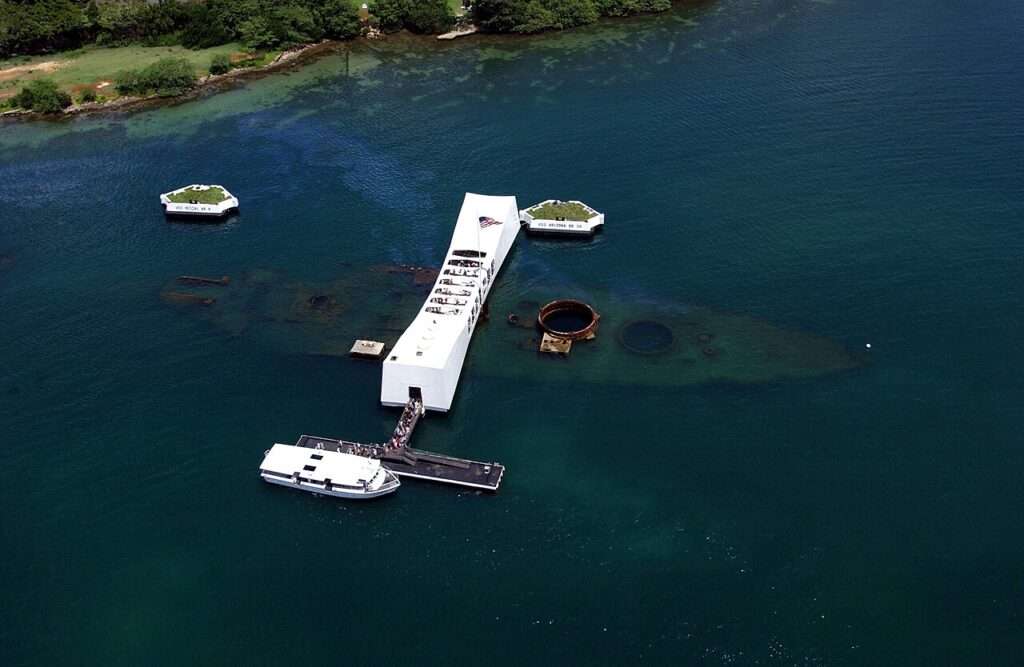
The USS Arizona memorial.
Following a short boat ride, they are taken to the memorial itself. The site consists of three main sections: the entry room, where visitors are introduced to the ship and its crew; the assembly room, an open area for contemplation and observation of the sunken battleship; and the shrine room, where the names of the fallen sailors and marines are engraved on a marble wall.
Perhaps the most poignant aspect of the USS Arizona Memorial is the constant seepage of oil from the wreckage of the ship. Even more than eight decades after the attack, the "tears of the Arizona" or "black tears" continue to rise to the surface, a somber reminder of the events of that fateful day and a tribute to those who perished.
Every year, the memorial receives over a million visitors, including veterans, families of the fallen, school groups, and those interested in understanding the history. The USS Arizona Memorial has transcended from being merely a monument to becoming a place of remembrance, reflection, and learning.
In essence, the USS Arizona Memorial symbolizes the enduring legacy of bravery, sacrifice, and unity that emerged from the devastating events of December 7, 1941. It serves as a powerful reminder of the events that changed the course of American history, and the world, forever.
The USS Arizona is more than a ship; it is a testament to the bravery of the men who served aboard her and the sacrifice they made for their country. From its inception as a symbol of naval prowess to its final resting place at Pearl Harbor, the USS Arizona encapsulates a critical period of American history.
As we remember the events of World War II, the USS Arizona Memorial continues to resonate as a monument to peace, a testament to valor, and a symbol of national remembrance.
No politics, no religion, no instagrams, and commentary must be civil. The ToS and the CoC will be enforced, and anything that the administrator deems to be offensive will be deleted. YouTubes, videos and images that the administrator is unable to open must be described and explained or they will be deleted.


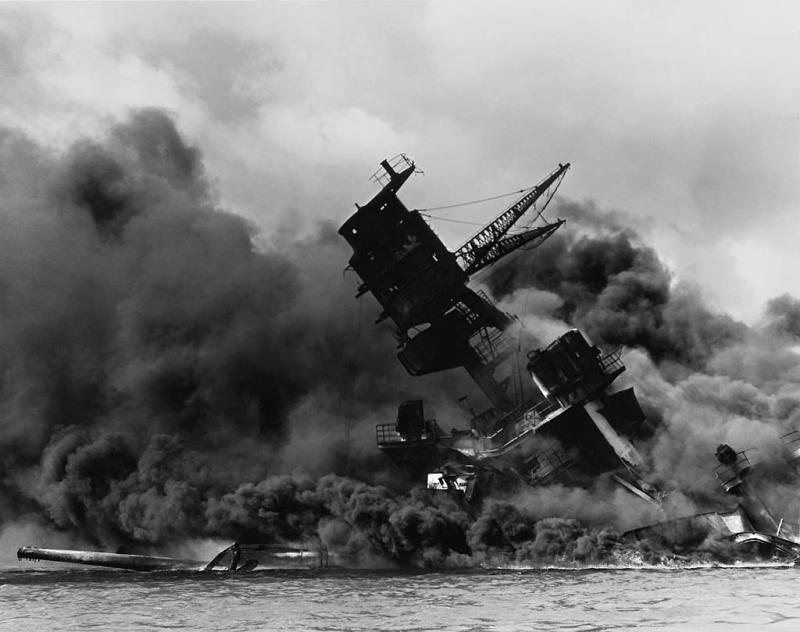





When I toured three Hawaiian islands during December of 1972 with a small group of friends we did not miss going to pay our respects at Pearl Harbor, but it was before the memorial's visitor centre pictured above was there.
I have been to the Arizona Memorial three times and also the ‘’Punch Bowl’’. It’s near impossible to explain the feeling standing there on the Arizona. The last time there I got to meet four survivors of Dec 7th and spoke with them for a good 1/2 hour. An experience that I’ll not forget.
Is the "Punch Bowl" that brown ring to the right of the visitors' centre in the coloured image above? (Wow - two red-underlined Canadian/British spellings in one sentence. LOL)
This is a photo of the Punchbowl, it’s the National Cemetery of the Pacific.
Oh, I see. Okay.
I retired from the Navy at Pearl Harbor in 1993. I had a husband and wife couple that worked for me decide they wanted to reenlist together onthe Arizona Memmorial and they invited me to attend. Got the chance walk around before the ceremony and I wound up in front of that huge marble slab with al the names of all the casualties from that day. I cannot adequately describe the flood of emotions that went through me as stood there staring and a rear coming down. It was a experience I will never forget.
The only time I could match your feelings about what you saw there was when I was in Yad Vashem, The Holocaust Museum in Tel Aviv. But I can imagine the feelings of all who view such an engraved wall, like in Nanjing (a/k/a Nanking) where the Japanese slaughtered 300,000 CIVILIANS.
While some Americans know about "The Rape of Nanking", many are unaware of Unit 731.
If anyone has a strong stomach, they can read about what was done there here:
Ooops-- sorry Buzz. That article is in Wikipedia and I had forgotten you don't have access to Wikipedia.
But you can use whatever search engine you have to search for "Unit 731".
Yes, I know about Unit 731. I don't know how China could EVER forgive the Japanese. As bad as Hamas was on Oct 7, I don't think they or even Mengele outdid them.
The Japanese apologized to China after the war, but Mao actually thanked them:
Mao Zedong , the longtime Chairman of the Chinese Communist Party and the founder of the People's Republic of China , was reported to have expressed his gratitude to the Japanese military and political figures who visited China in the 1950s and 1970s. Mao said that the Japanese invasion of China had united Chinese people and allowed the Chinese Communist Party to win the Chinese Civil War . In the 21st century, these remarks by Mao caused strong reactions on the internet in China . With the 2020 Hong Kong Diploma of Secondary Education Examination (HKDSE) history subject controversy on the historical understanding of Japan's invasion of China, [ 1 ] [ 2 ] these remarks have returned to the spotlight on Hong Kong and mainland Chinese websites. [ 3 ] The word "thanks" expressed by Mao has been also interpreted by some observers as dark humour . [ 4 ] [ 5 ]
Mao Zedong thanking Japan controversy - Wikipedia
I'm going to assume it was sarcasm, or else he was senile.
Malwarebytes identified and blocked this site (navalhistoria.com) as a phishing attack.
Pictures were blocked.
YOU'RE KIDDING!!! That is ridiculous. I had no trouble opening it OR copying it, and I get blocked from MANY things. Can you not see the images above?
It comes up fine for me, Buzz.
Maybe Malwarebytes knows something about Greg that we don't. LOL
Comes up fine for me as well. Here, and at the link.
I guess only Greg has that problem.
Same here.
Are you using a VPN? If so if you change one of the settings you might be able to access it.
I started using a VPN. One of the settings (which is easy to turn off, and turn back on as desired) is that it blocks any advertising sites. There was a site I wanted to see that it blocked as an "advertising site".
(Although it seems in your case its Malwarebites, not a VPN)
It actually wasn't anad site although it did have links to ads thsat popped up when clicking some links of the site... I turned of the ad-blocking feature and i could see the site. (Then I turned the "ad block" back on)
I went to the website to see what would come up and got this....Malwarebytes is pretty fussy. Recommend it if you don't have it
The connection for this site is not secure
navalhistoria.com sent an invalid response.
This could be caused by a variety of factors. Given the rest of us can access the site, the problem might be your machine. You might want to clear your browser cache, clear your cookie for the site, do a hard boot of your machine.
Greg, please check another seed that I've posted to see if the same thing happens, and let me know.
Doesn't seem to happen on your other threads.
I was concerned that your malware program might have indicated that I was the cause of your problem, but now I know that obviously it is not caused by me. Then for sure the problem is yours alone.